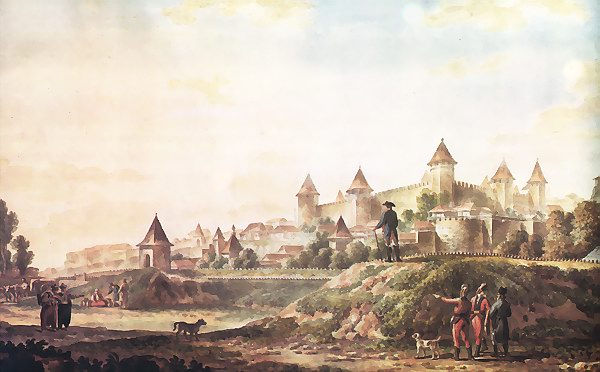280 years ago, on September 24 (13 according on old style), an outstanding statesman and military leader, diplomat, field marshal, His Serene Highness Knyaz Grigory Alexandrovich Potyomkin-Tauric was born, who played an important role in the Pridnestrovie fate. His name is associated with the liberation of our lands from Ottoman rule and their inclusion in the Russian Empire, the settlement of the region and the new cities foundation.
The Way to the
Grigory Potyomkin was born in the village Chizhovo, Smolensk province. After his father death, Grigory and his mother move to Moscow.
First, Potyomkin attended Litken's shool in the German settlement, and then moved to Moscow University. In 1756, he was awarded a gold medal for his achievements in science; in 1757, among 12 worthy students, he was presented to Empress Elizaveta Petrovna in
Since 1755 he was enlisted in the Horse Guards, in 1757 he was promoted to corporal.
The participation of Potyomkin in the coup of 1762, culminating in the reign of Catherine II, left an indelible mark on his future fate.
Having become famous in the Russian-Turkish war of 1768-1774, Potyomkin, being in the rank of lieutenant general, drew the attention of Empress Catherine II. According to some reports, they secretly married in July 1775. Despite the fact that the Empress relations with the minion quickly chilled, over the next 15 years Potyomkin became the main policy conductor of Catherine II.
“It was another rare quality that distinguished him from all other people: he had courage in his heart, courage in his mind, courage in his soul. Thanks to this, we always understood each other and did not pay attention to the rumors of those who understood things less than us. In my opinion, Potyomkin was a great man who did not fulfill even half of what he was able to,” Catherine II wrote after her minion’s death.
Potyomkin`s Geopolitics
Potyomkin is one of the ambitious Greek Project creators. Its essence was as follows: firstly, the complete expulsion of the Turks from Europe; secondly, the restoration of the Byzantine Empire, the crown of which was intended for the grandson of Catherine II, Grand Prince Konstantin Pavlovich; thirdly, the formation of the buffer state of Dacia from Moldova and Wallachia, which would divide the borders of Russia, Austria and the new Greece. According to this plan, the southern border of
The implementation of the plan began with the Crimea annexation to Russia in 1783, after which Potyomkin received the title of Tauric to the His Serene Highness. A few years later, a new round of Russian-Turkish military confrontation began. The territory of Pridnestrovie, which became an active hostilities zone during the war, was cleared of the enemy by the end of

During the hostilities in Pridnestrovie, the Black Sea Cossack army, also formed by order of the His Serene Highness Knyaz particularly distinguished itself.
"The Army of Faithful Cossacks"
Soon after the destruction of the Zaporizhian Sich, Knyaz Potyomkin had the idea of resuming the Cossack army existence in order to protect the newly formed Novorossiysk province borders. In 1783, he gave permission to the former Cossacks Anton Golovaty, Zakhary (Horyok) Chepege and Sidor Bely (Legkostup) to "invite hunters to serve in the Cossack rank." In 1787, Catherine II, to whom the deputies of the former Cossacks introduced themselves in Kremenchug, agreed to restore the old army under the name "the loyal Cossacks troops." So the Black Sea Cossack army was created, which included the Cossacks of the former Zaporizhian Sich and volunteers among the "free people".
They were granted land liberated during the Russo-Turkish war on the left bank of the

“The Cossacks had a huge impact on the culture of our lands. Even today, Cossack surnames such as Chernov, Zvyagin, Nebeigolova and others are very common here. The Russian part of Slobodzeya differs from the Moldavian one, and there is a difference in the houses architecture,” the Director of the Slobodzeya Museum Association Victoria Cheban told IA Novosti Pridnestrovya correspondent.
Settlement of Pridnestrovie
The successes of General Alexander Suvorov near Rymnik and Ishmael, as well as the virtuoso actions of the fleet of Admiral Fedor Ushakov in the Black Sea, created favorable conditions for the conclusion of a peace favorable to Russia. Potyomkin pushed the idea of the complete liberation of the Principality of Moldova from
One of the crucial Potyomkin`s administrative projects, which predetermined the future of the region, was the development and settlement of newly acquired lands. Privileges for free settlement were granted to foreign colonists, the Russian Empire subjects and the peoples under the Turkish yoke. So, Potyomkin initiated the foundation of the largest Armenian colony on the Dniester - the town Grigoriopol. It is called the town of two Grigories - St. Grigory the Illuminator, whose name is associated with the adoption of Christianity in Armenia in the IV century, and His Grace Knyaz Grigory Potyomkin.

The policy of colonization that he began was continued by the Governor of Yekaterinoslav Vasily Kakhovsky and the Governor General of New Russia Arman de Richelieu. 60 years after Potyomkin’s death, the Military Statistical Review of the
*****
In Pridnestrovie, to the memory of the His Serene Highness the Knyaz, there was erected a bronze monument at the entrance to the military-historical memorial in Bendery. The name of an outstanding statesman and military figure is immortalized in street names, numismatics, philatelic products. The Republican Cadet Corps was named after Grigory Potyomkin.








